#bell XV15
Text

-Transcendental 1G (N2704A). | Photo: JOHAN VISSCHEDIJK COLLECTION
Flightline: 61 - Tiltrotors
Early Experiments.
Almost before the first flight of a heavier-than-aircraft, research has looked into combining the vertical takeoff and landing abilities of a helicopter with the long range and high speed of an airplane. One of the concepts identified was the tiltrotor, in which the the propellers, either connected with shaft to the engines or mounted as a unit in nacelles, are able to be tilted through 90°, allowing them to function as helicopter blades for vertical flight and as propellers for horizontal. Brothers Henri and Armand Dufaux began work in 1902, with a patent being awarded in 1904. George Lehberger patented the first recognizably modern tiltrotor in May of 1930, though it was never built. Prior to WW2, the Weserflug company designed their P.1003/1, which would have been a hybrid of tiltrotor and tiltwing designs. A Daimler-Benz DB600 piston engine was to be mounted in the fuselage, and linkages would transfer power to the wingtip-mounted propellers. the wings were split approximately half-way along the span, and they would tilt along with the nacelles holding the propellers. The P.1003 was never built, though it did establish some concepts for future tiltrotors and tiltwings.

-Orthograph of the P.1003/1. | Illustration: luft46.com
Concurrently, Heinrich Focke designed the Focke-Achgelis Fa.269 went in a different direction, with the rotors facing downwards for VTOL and swiveling backwards 80° for horizontal flight. Focke carried out extensive wind tunnel tests, along with bench tests of the gearboxes and pivoting mechanisms, but the design did not advance beyond a full-scale wooden mockup before Allied bombing ended work.
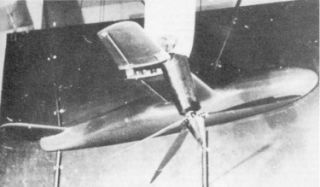
-Fa.269 wind tunnel model. | Photo: Enno Springmann
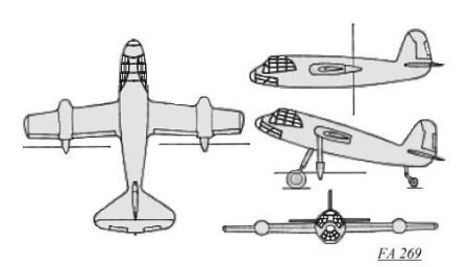
-Orthograph of the Fa.269. | Photo: luft46.com
Post-war: Trancendental Aircraft.
After WW2, two former employees of Kellet Aircraft formed Transcendental Aircraft Company to work on a tiltrotor design of their own. The Model 1-G was powered by a Lycoming O-290-A flat-four engine which drove two 3-bladed rotors, controlled by a cyclic and collective. Despite heavy damage caused by the rotor blades shattering on a test rig in 1951, funding from the USAF allowed Transcendental to complete the Model 1-G in 1954, and the plane took its first tethered flight on 15 June, with an untethered flight occurring on 6 July. Flight testing continued until a control failure led to a crash on 20 July 1955, injuring the pilot but destroying the 1-G. The tiltrotor completed 23 hours of flight time, and although it did not completely transition from vertical to horizontal flight, tilt angles of up to 75° were explored, with up to 90% of the plane’s lift being provided by the wings, making it the first functional tiltrotor.

-Transcendental 1-G in flight. | Photo: reddit
The success of the Model 1-G allowed Transcendental to refine the design into the Model 2, which flew in 1956. The Model 2 was powered by a Lycoming O-435-23 six-cylinder, and the enclosed cockpit could accommodate two. USAF funding dried up however, with the government becoming more interested in the Bell XV-3. The Model 2 was abandoned, and Transcendental was sold to Republic.
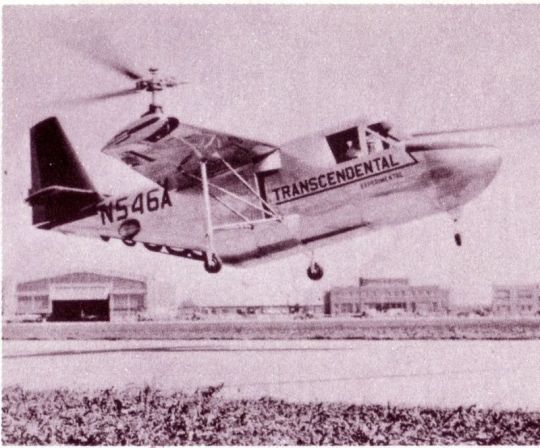
-Transcendental Model 2 in flight. | Photo: Transcendental Aircraft
Bell XV-3
The result of a joint program between the USAF and US Army, the Bell XV-3 was the first successful tiltrotor design, and the ultimate ancestor of the V-22 Osprey. Powered by a Pratt & Whitney R-985-AN-1 Wasp Junior piston engine in the fuselage, the XV-3 was fitted with two 3-bladed props during initial testing, but the second example flew with two-bladed props. The first XV-3 was damaged beyond repair during a test flight in 1956 when extreme vibrations caused the pilot to black out. After extensively redesigning and reinforcing the second XV-3 (serial number 54-148), the type restarted test flights in 1958, though vibrations and instability continued to plague the design. As a result of wind tunnel testing, the rotor diameter was reduced and the wing structure was stiffened again. Tests resumed once more, and the XV-3 achieved a full transition from vertical to horizontal flight on 18 December 1958.

-Illustration of the XV-3 transitioning from vertical to horizontal flight. | Illustration: Bell Aircraft
Flights continued until 1962, after which the XV-3 was subjected to a series of wind tunnel tests with the aim of eliminating a dangerous condition known as pylon whirl, which had led to severe vibration and instabilities throughout the program. These tests ended in April of 1966, when both rotors failed, damaging both the XV-3 and the 40x80 wind tunnel at NASA Ames. The damaged XV-3 was found at AMARG in 1984, and under the leadership of former Bell XV-3 engineer Claude Leibensberger the tiltrotor was partially repaired and placed in storage. In 2005 Bell employees began a two year restoration of 54-148, after which it was transferred to the USAF Museum in Dayton, where it has been on display in the R&D Gallery since 2011.

-The 2nd XV-3 on display at the NMUSAF. | Photo: Maria Trusty
Bell XV-15
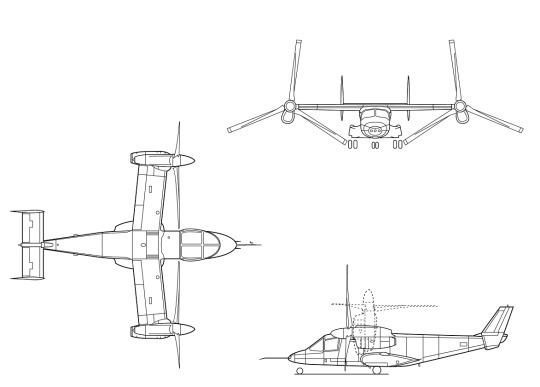
-Orthograph of the XV-15. | Illustration: NASA
In 1972, NASA awarded a contract to Bell Helicopter for what would become the XV-15. The XV-15 was designed to simplify the conversion process and improve performance, and as such it was powered by two Textron Lycoming LTC1K-4K turboshafts in nacelles mounted at the ends of the wings. This eliminated the complex gearing and shafts linking the propellers to the engine as seen in earlier types, though a cross-linking shaft was included in case of an engine failure. The XV-15 also took advantage of improvements in avionics and materials, further improving the transition from vertical to horizontal flight. Flight testing of the XV-15s commenced in 1977, with one being displayed at the 1981 Paris Air Show.
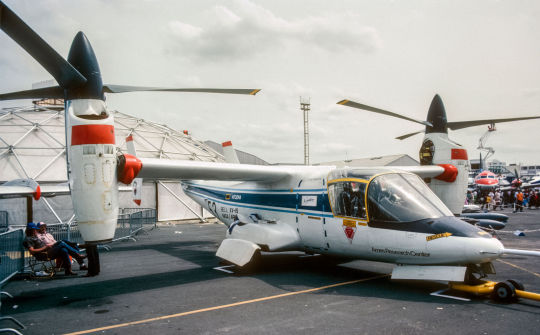
-Bell XV-15 N702NA at the 1981 Paris Air Show. | Photo: Acroterion
N702NA was later damaged beyond repair on 20 August 1992 when a bolt slipped out of the collective control system on one pylon, causing that rotor to go to full pitch. The aircraft rolled uncontrollably and impacted upside-down, injuring both crew. The XV-15 was deemed uneconomical to repair, but the cockpit was salvaged and used as a simulator. The second XV-15, N703NA, was used in NASA test flights until 2003, after which it was placed on display at the Smithsonian National Air & Space Museum’s Steven F. Udvar-Hazy Center at Washington Dulles International Airport. The data generated by the XV-15 program led to the Bell/Boeing V-22 and Bell/Augusta BA609.
#aircraft#aviation#avgeek#airplanes#airplane#aviation history#nasa#ww2#wwii#experimental aircraft#experimental#tiltrotors#tiltrotor#tilt rotors#xv3#bell xv3#xv15#bell XV15
26 notes
·
View notes